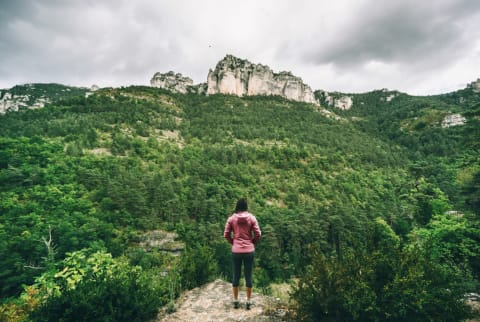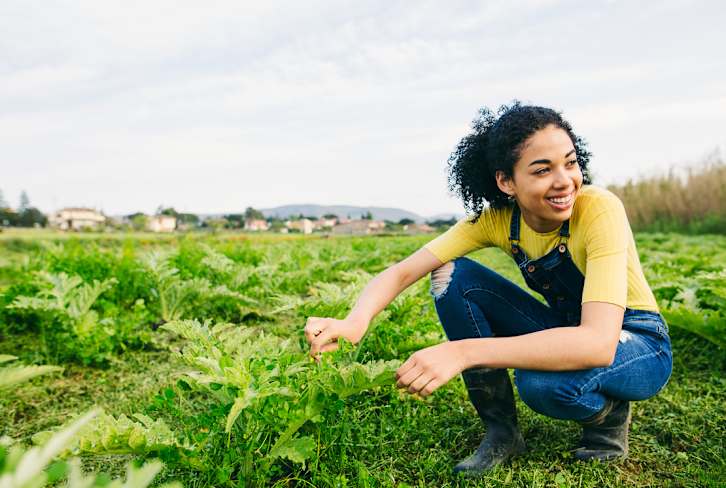Advertisement

By now, we’ve all gotten the message that our environment needs as much love as humanly possible, and we’re doing our part to help make that happen. Still, while we have the best intentions to be all eco-friendly all the time, just thinking about how much work still needs to be done can get overwhelming—and make even the greenest person feel a little blue.
That’s why it’s more important than ever to zero in on small changes that actually make a tangible difference. The actions below are a great place to start—and an even greater reminder that when we all do our part to help save the planet as a collective whole, that’s when the positive results really happen.
1. Eat more plant-based foods.
One way to do this: Dedicate one day a week to not eating meat. You’ve heard of Meatless Mondays, but the truth is, you can go meatless on any day of the week. And it’s a really good idea: The United Nations’ Food and Agriculture Organization estimates that the meat industry alone generates almost one-fifth of the manmade greenhouse gas emissions that are contributing to climate change around the world. Put another way, beef is 34 times more climate-pollution intensive than foods like beans and legumes, on a pound-for-pound basis.
What’s more, producing meat also uses up a ton of water—up to 2,500 gallons of water go into making a single pound of beef (as opposed to soy tofu, which, in California, requires only 220 gallons per pound). The good news? If you skip meat just one day a week over the course a year, it’s the equivalent of not driving for three entire months. Check out these delicious veggie-heavy recipes for some meat-free inspiration.
If you skip meat just one day a week over the course of a year, it’s the equivalent of not driving for three entire months.
2. And eat locally as often as you can, too.

We don’t have to tell you twice that eating locally is better for the Earth and for your health. But just to remind you why it’s so great: According to the Leopold Center for Sustainable Agriculture, the average fresh food item in America travels 1,500 miles to get to its final destination. So the more you choose to buy and eat locally, the more fuel you will save along the way. To find great local food near you, check out the Local Harvest website—it’s got a national directory of farmers’ markets, farm stands, and other places to get locally-sourced goods.
The average fresh food item in America travels 1,500 miles.
3. Take shorter showers.
Taking a soothing shower is likely already part of your self-care routine. And while that’s great for relaxation, it’s not so great for the Earth if you take too long in there. The compromise: Shorten your shower to around five minutes. An average shower in America lasts for about 8.2 minutes and uses about 17.2 gallons of water, at roughly 2.1 gallons per minute. So if you cut back by just about three minutes, you can save almost seven gallons of water. To make it happen, play a five-minute song and hop out of the shower once it’s over. If you still can’t get yourself down to five minutes, try turning the water off while you shampoo or shave your legs, and then turning it back on to rinse off.
4. Switch to reusable water bottles and bags.
It’s all about the BYOB life—bring your own bottle/bag. Consider that 42.6 billion plastic water bottles are purchased in the U.S. each year. If you switch to a reusable water bottle, though, you can save 217 plastic water bottles from going to the landfill. Also, the United States uses 100 billion new plastic bags each year, and it takes between 15 and 1,000 years for a plastic bag to decompose. And, sadly, paper bags aren’t much better, either. The U.S. cuts down 14 million trees per year in order to make enough of them. That’s why it’s more important than ever to either bring your own reusable bag, or even use the same bag from the store over and over again. If you switch to reusable bags for good, forever, you could end up saving 22,000 plastic bags just you alone—now imagine what could happen if everyone else did, too.
More than 50% of 'fast fashion' pieces are thrown away within a year.
5. Give your wardrobe an eco-friendly makeover.
According to a report put out by the MacArthur Foundation last year, the fashion industry is pretty harmful to the environment, creating more carbon emissions than some airlines. The report featured some alarming statistics, including the fact that the industry generates 1.26 billion tons of greenhouse emissions each year, and half a million tons of plastic microfibers from clothes are lost during the washing process—and end up in the ocean. As if that’s not alarming enough, more than 50% of “fast fashion” pieces are thrown away within a year.
Fortunately, there are ways to lower these numbers. For starters, go for eco-friendly clothing brands that don’t use synthetic materials and instead use more sustainable fabrics, like certified organic cotton, hemp, and recycled wool. Check out this sustainable shopping guide if you need some inspo. Next, you can also recycle your own clothes. Consider dropping them off at your local thrift store so that they will be reused and repurposed, or look for denim brands with recycling programs, like Madewell.
6. Turn your home into a green oasis.
Sure, it’s important to know where your clothes are coming from, and who’s growing your food (best yet if it’s you). But it’s also just as crucial to get deep into the weeds of home sustainability. Choose an organic mattress, eco-friendly sheets, eco-friendly paint, and LED lightbulbs, which use a lot less energy than the traditional kind. In fact, LED lights can be up to 80% more efficient than traditional ones, which helps decrease greenhouse gas emissions and reduces the energy needed from power plants. Check out these tips for even more ways to green your bedroom.
7. Support the efforts of do-good organizations.
There are tons of great organizations out there that are working hard to help preserve our planet and educate people about the importance of sustainability. One that deserves your love is the Jane Goodall Institute. The organization works to push Dr. Jane Goodall’s conservation vision forward every single day by mobilizing the collective power of individual action to save our planet (exactly what this list is all about)—and protect the animals who call it home, too.

One easy way to support them right now: Stock up on Lily of the Valley, a special edition deodorant created in partnership with Schmidt’s Naturals. Inspired by one of Dr. Jane Goodall’s favorite scents, the fresh, floral natural deodorant is certified vegan and cruelty-free. And the best part? Five percent of every purchase will benefit the Jane Goodall Institute’s efforts to protect animals and conserve the environment.* Now that’s what we call global goodness.
Small steps have the potential to create widespread change.
8. Rethink your commute.
We know that all of the driving in America is not just bad for our psyches—TRAFFIC!—it’s also bad for the Earth. Fortunately, it’s easier than you may think to make a difference just by choosing to ride your bike or walk. A study from the Institute for Transportation and Development Policy found that bicycling could help cut carbon emissions from urban transportation by 11 percent. Plus, it’s healthier, too—a total win-win.
9. And switch up your next vacation, too.
Consider traveling by train for your next trip, rather than plane. Taking the train is not always possible, but if you do have a choice, it could have more impact than you may realize. The UK-based Aviation Environmental Federation reports that taking a high-speed train emits 165-180g of carbon per kilometer, whereas a long-haul flight brings you up to 210-330g—and a shorter-haul flight is even worse, coming in anywhere from 300-460g.
That’s a big difference, and one you can calculate for all of your trips, too. Just go to the travel sustainability website Eco Passenger, type in your destination, and it will help you compare the energy consumption, CO2 emissions, and other environmental impacts for planes, cars, and trains. Bonus: On top of helping the environment, taking the train can be incredibly romantic, too.
10. Shop more mindfully if you eat meat, eggs, and dairy.
We're not alone on this planet. So our daily decisions also affect our fellow Earth-dwellers, too. Specifically if you eat meat, eggs, and dairy, every grocery store purchase is a vote for more humane farming practices and a better life for animals who are raised for food. We're talking 10 billion farm animals in the U.S., and according to the ASPCA, 95% of them are raised in large-scale factory farms that are unregulated and rely on routine antibiotics just to keep animals alive in unhealthy conditions—not great for them, us as humans, or our climate.
Buying food with these specific animal-welfare approved labels, and again, buying locally and talking to the farmers about their practices, all help move us in a better direction—seriously! By estimates from the National Resources Defense Council, more and more chicken producers and fast food chains make commitments to improve their practices every year, and now more than half of the chicken industry is moving away from using routine antibiotics. Together we can all keep this kind of good news growing.
For full terms, including charity financial, licensing and additional info visit schmidtsnaturals.com/JGI
Watch Next
Enjoy some of our favorite clips from classes
Enjoy some of our favorite clips from classes
What Is Meditation?
Mindfulness/Spirituality | Light Watkins
Box Breathing
Mindfulness/Spirituality | Gwen Dittmar
What Breathwork Can Address
Mindfulness/Spirituality | Gwen Dittmar
The 8 Limbs of Yoga - What is Asana?
Yoga | Caley Alyssa
Two Standing Postures to Open Up Tight Hips
Yoga | Caley Alyssa
How Plants Can Optimize Athletic Performance
Nutrition | Rich Roll
What to Eat Before a Workout
Nutrition | Rich Roll
How Ayurveda Helps Us Navigate Modern Life
Nutrition | Sahara Rose
Messages About Love & Relationships
Love & Relationships | Esther Perel
Love Languages
Love & Relationships | Esther Perel











